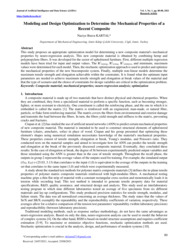Modeling and Design Optimization to Determine the Mechanical Properties of a Recent Composite
-
Eser Sahibi
Naciye Burcu KARTAL
-
Tür
Makale
- Yayın Tarihi 2021
-
Yayıncı
İzmir Katip Çelebi Üniversitesi
- Dergi Adı Journal of Artificial Intelligence and Data Science 1, ( 1 ), pp.80 - 88
- Tek Biçim Adres https://hdl.handle.net/11469/1933
-
Konu Başlıkları
Composite material
Kompozit malzemeler
This study proposes an appropriate optimization model for determining a new composite material's mechanical properties by neuro-regression analysis. This new composite material is obtained by combining hemp and polypropylene fibers. It was developed for the sector of upholstered furniture. First, different multiple regression models have been tried for input and output values. The R2 training, R2 testing, R2 validation, and minimum, maximum values were determined for each model. Then, the stochastic optimization approach is used to predict and optimize the mechanical properties of the new biocomposite system. Finally, multiple non-linear models determine the maximum tensile strength and elongation achievable within the constraints. It is found what the optimum input parameters are needed to achieve maximum tensile strength and elongation at break values of the material and that the type of scenario and the choice of constraints for design variables are critical in the optimization problem.

 Tam Metin
Tam Metin

